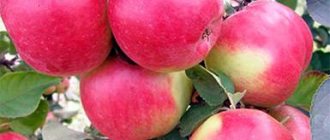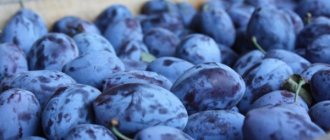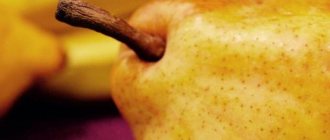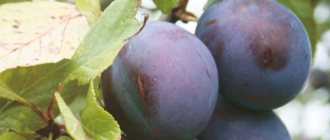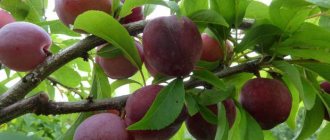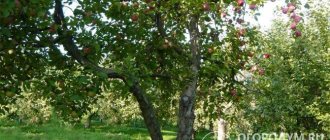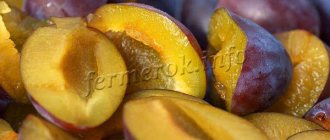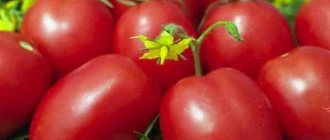Description of the variety
As a result of experiments on crossing the Skorospelka red and Victoria plums, breeders V.A. Efimov and Kh.K. Enikeev obtained a variety - Memory of Timiryazev, which became famous back in 1959. The variety is, as they say, old-school, tested by time and not always predictable weather.
Plum Memory Timiryazev, a time-tested variety
The tree can be called compact. The height of an adult plum does not exceed 3 m. The shape is rather bush-like, with a round, slightly drooping and not very thick crown. The shoots are long, slightly pubescent, colored light brown. The small buds are slightly deviated from the shoot. Fruits on bouquet branches and annual growths.
The flowers are large, white, cup-shaped. Very fragrant.
Plum Memory Timiryazev blooms in mid-May
The leaf has an obovate shape and a slightly wrinkled surface. The edges are jagged, the underside is slightly pubescent. The color of the leaf blade is light green.
The ovoid fruits of the plum are of medium size, their weight ranges from 20 to 25 g. The main color is yellow, but as they ripen, a reddish-pink outer blush with dark red subcutaneous dots appears. The skin is smooth, covered with a slight waxy coating. The ventral suture is poorly developed.
Plum fruits Memory of Timiryazev look very attractive
The flesh is a pleasant amber-yellow color. Quite dense, with a fine-grained consistency. The juice content in the fruits is average. The aroma is weak. The sugar content is at an average level, so the taste is dominated by sourness. Taster rating: 4.2 points.
The seed is oval in shape, weighing 1 g, which is 5.5% of the total weight of the fruit. It separates from the pulp quite easily. The peduncle is medium. Dry fetal separation.
The variety is zoned in Moscow, Tula, Ryazan and other regions of the Central and Middle Volga regions.
Table: chemical composition of fruits
| Substances | Content |
| Solids | 15% |
| Sugar | 9,3% |
| Free acids | 1,4% |
| Ascorbic acid | 11 mg/100 g |
Distinctive features
The tree is considered durable - it can bear fruit for up to 21 years. It has good recoverability, inherited from Skorospelka red.
Features of cultivation
Immediately after planting the plum, you will have to actively care for it. In the first 3–4 years, care lies in the formation of the crown and watering, and a fruit-bearing tree also requires fertilizing. The soil under a tree of any age should be loose, moist and covered with mulch.
Formation of plum bush and thinning
The downside of being formed by a tree (one trunk and skeletal branches) is that fruiting goes to the periphery of the crown and upwards. We need a bush, all covered with fruits that can be collected without any stairs. This pruning method is applicable not only for plums, but also for cherry plums, peaches, cherries, sweet cherries, and apricots:
- Immediately after planting, cut a one- or two-year-old seedling at a height of 30–40 cm above the soil, and not at the usual 60–70 cm.
- Over the summer, you will grow a bush with shoots of approximately equal length and thickness. Leave it to spend the winter like this.
- In the second year, cut all shoots at a height of 1 meter from the ground, that is, all at the same level.
- In subsequent years, prune at arm's length. The bush will grow in breadth and produce rich harvests. In addition, this plum looks very decorative, especially during flowering.
- In addition to shaping, carry out sanitary cutting and thinning. To do this, remove all broken, crooked, diseased and frozen branches. Also remove those growing inside the bush that intersect with each other.
- With this formation, replacement shoots will actively grow from the lower part of the trunk. Remove weak and thickening crowns. Over time, cut out old 5–6-year-old shoots with grayed, cracked bark, and leave young ones as replacements.
Do all pruning in early spring, before sap flows. Don’t be afraid to go out into the garden when the ground is still cold and there is snow in places.
Plum when forming a bush in the third year after planting
When and how to water
The Memory Timiryazev variety is characterized by average drought resistance, so do not leave the plum unattended, especially in the hot summer. It is necessary to water during the budding period, immediately after flowering, and while the fruits are growing and filling (June-July) at least twice a month, that is, every 2-3 weeks. Charging watering is also necessary in October. But if it rains, or the soil, thanks to the mulch, is wet, you don’t have to water it. That is, the main signal for watering is dry soil under the mulch.
Water must be poured at the root; moisture on the leaves is a habitat for fungal diseases. Each time, make a hole as when planting: loosen and rake the soil from the trunk to the periphery, do not flood the neck. The rate of watering depends on age. In the first 2 years, 3-4 buckets are enough, for an adult tree - 6-8, autumn watering is more abundant - 15-20 buckets.
Video: basic rules for watering and fertilizing
Feeding
If you have filled the planting hole with fertilizers, then the plum tree does not need fertilizing before fruiting begins. “Feed” an adult tree according to the following scheme: loosen the tree trunk, sprinkle fertilizer, mix with soil and water with clean water.
Table: fertilizers for fruiting plum
| Deadlines for depositing | Fertilizers and dosage per 1 m² of tree trunk circle |
| Before flowering | 30–40 g each of urea and potassium sulfate |
| During fruit filling | 25 g nitroammophoska |
| Immediately after harvest | 30 g each of potassium sulfate and superphosphate |
| Late autumn before frost sets in | spread humus or compost as mulch in a layer of 10–15 cm |
Organic matter should be added every year only to poor soils, to fertile soils rich in humus, chernozem - once every 4 years.
Shelter for the winter
Whiten the lower part of the plum above the snow level traditional for the region with garden lime. It is better not to bleach young seedlings, so as not to burn their delicate bark, but to wrap them entirely with covering material. A plum formed by a bush has a short trunk and many branches extending almost from the ground. To make it more convenient to wrap them up for the winter, tie them together with a cord or a soft ribbon made of fabric, such as an old sheet.
The branches are tied together with soft tape for compactness.
To protect against frost, wrap it with covering material, burlap; some gardeners wrap fruit trees with newspapers and even wallpaper. You need to build protection from rodents on top, for example, wrap it in fine mesh. You can use spruce branches with needles down and raspberry stems. Ruberoid, film and other materials that do not allow air to pass through cannot be used. Cover the trunk circle with a thick layer of mulch (15–20 cm): sawdust, hay, straw, spruce branches, fallen leaves.
Use rotted sawdust as mulch; fresh sawdust takes a lot of nitrogen from the soil and acidifies it. Before spreading fresh sawdust around the garden, mix it with 200 g of urea per 3 buckets and pour water (10 l), cover with film, leave for 2 weeks.
In early spring, immediately after the snow melts, all shelters must be removed. Remove the mulch too, the ground under it will take a long time to thaw and the flowering will move away. Lay a fresh, loose layer of 5–7 cm.
Video: how to prepare plants for winter
Advantages and disadvantages
The variety, which has been popular for decades, has many advantages. But, depending on the region of planting or poor quality care, some disadvantages may appear.
| Advantages | Flaws |
| Productivity is stable, above average | Insufficient frost resistance |
| Has good immunity to common plum diseases - clasterosporia and fruit rot | Resistance to pests is low, mites are especially dangerous |
| Fruit quality and transportability at a high level | Medium drought resistance |
| Fruits have a universal purpose | |
| The variety is self-fertile |
Fruits have a universal purpose
Planting and care
Timiryazev's Memory can be planted in the spring, before the seedlings begin to bud, or in the fall, when there are at least 2-3 weeks left before the onset of persistent cold weather. It is advisable to choose a site that is sunny, protected from the prevailing winter winds, with a groundwater level no higher than 1.5 meters to the surface. Watering is carried out as needed. Be sure to carry out preventive spraying against pests. Pruning is carried out in the spring, freeing the crown from thickening. In particularly harsh winters, the trunk, skeletal branches and root zone should be insulated.
Memory Timiryazev is valued for its self-fertility, the ability to quickly recover after a hard winter and for the good quality of the fruit. Plums are easily transported and processed into tasty and healthy preserves. The disadvantage of this variety is its lack of winter hardiness and resistance to pests.
Diseases and pests characteristic of the variety
The Pamyat Timiryazev variety is resistant to common plum diseases—clusterosporiosis and fruit rot are not harmful to the tree. But besides them, there are many more diseases that affect weakened and unkempt plum trees. And pests cannot be excluded from the list of dangers.
Table: diseases and pests, how to recognize and fight
| Diseases and pests | How do they manifest themselves? | Control measures | Prevention |
| Polystigmosis or red spotting | Both sides of the leaf are initially covered with pale, blurred spots, which then acquire a yellow or reddish color. On the upper side of the leaf the spots are convex, on the lower side they are concave. The formations are dense to the touch. If the weather is damp, the leaves will fall off quickly. In dry weather they will last longer and spores will have time to form on them. | Before the buds open, treat the plum with Nitrafen - 300 g per 10 liters of water. After flowering, use Bordeaux mixture - 100 g per 10 liters of water. In case of severe damage, re-treatment is carried out after 2 weeks. | Collect and burn all fallen leaves under the tree. Loosen the soil in the tree trunk circle. |
| Witch's broom | The leaves of the affected branches become small, pale or acquire a reddish color. To the touch, the leaf plate is fragile, with wavy edges and a wrinkled surface. At the end of summer, a gray coating forms on the bottom of the leaf - fungal spores. | During the swelling of the buds, spray the plum with a solution of Bordeaux mixture - 300 g per 10 liters of water. After flowering, apply a 1% solution of Bordeaux mixture or another fungicide. | Affected branches on which numerous shoots are formed should be cut off and burned. Collect and destroy fallen leaves. |
| Plum pox or sharqa | In spring, the leaves become covered with chlorotic ring spots of varying sizes. As the disease develops, the surface of the leaf becomes marbled, with distinct dark and light green areas. Fruits are also affected. Depressed dark green spots, stripes or rings appear on them. The pulp becomes unfit for consumption. | This virus has virtually no cure. Affected trees must be uprooted and disposed of. Preventative measures are the only way to contain the spread of the disease. | Choose only healthy planting material. Prevent aphids and mites and deal with them in a timely manner. When pruning, disinfect the tool. Graft only healthy cuttings. |
| Plum gall mite | It damages young shoots, at the base of which a fleshy, rounded growth appears - a gall. At first it is red, then it becomes the same color as the shoot. The growth of shoots stops, they wilt and the ovaries fall off. If the tree is not treated, the plum may die in 3 to 6 years. | Spray with acaricidal preparations (for example, a sulfur preparation - propargit) at the budding stage. The solution is prepared according to the instructions. Use when heat and humidity are low. | Collect damaged leaves and burn. In the fall, clean and whiten the trunk. Remove root shoots and weeds. |
| Fruit sapwood | The dark brown beetle makes passages in the bark or wood of a tree, where it overwinters and lays eggs. The tree weakens and gum appears on it. | When beetles emerge from under the bark, Metaphos or Chlorophos is used. The trunk and branches are generously moistened with the preparation. After 2 weeks, the treatment must be repeated. | Follow agricultural practices and plum care rules. Do not overfeed trees with nitrogen. Damaged branches should be cut off in early spring, before the beetle begins to fly, and burned. Dead trees should be uprooted and destroyed. |
| Red fruit mite | It likes to settle on young leaves, sucking the juices from them. The plant weakens due to a decrease in the amount of chlorophyll and the suspension of photosynthesis. The fruits become smaller. | Before the buds open, treat the plum with Nitrafen or Oleocuprite. Drugs can be alternated. In case of severe infestation, you can re-spray a month before harvest. | Clean the exfoliated bark and whitewash the trunks. Collect fallen leaves and burn. Dig up the soil under the tree. |
Photo gallery: how to recognize diseases and pests
Plum polystigmosis can cause early leaf loss
On branches affected by the witch's broom, many thin shoots with small leaves grow.
Plum pox or sharqa makes the fruit unfit for food
If you do not treat a plum tree for gall mites, the tree may die.
Due to damage to wood by sapwood, gum may develop in the plum tree.
By sucking juice from young leaves, the mite interferes with the process of photosynthesis
Features of planting Timiryazev plum
Before planting a plum tree, you need to evaluate your capabilities and the area. Not every piece of land is suitable for a new settlement. And you need to approach the purchase of seedlings wisely and know the weak points of the crop.
Landing dates and location selection
The best time for planting is spring, before the buds open. If you purchase a seedling with a closed root system, in a container, then you can plant it from spring to October. When choosing a place for a plum, keep in mind that the feeding area for it is 9 m² or 3x3 m, that is, you need to retreat at least three meters from fences, buildings and other crops.
Be sure to choose a sunny place, only in this case you will get sweet and large fruits. The Memory Timiryazev plum is not highly winter-hardy, so place it near outbuildings, preferably with brick walls, on their southern side. The brick heats up in the sun and then gives off heat. In addition to this heat exchange, the tree will also receive protection from the cold wind.
The seedlings are placed on a sunny hillock, protected from the winds by a forest belt
Plum does not like flooding and stagnation of water at the roots. Lowlands are contraindicated for it; it grows well on hills and slopes. The groundwater level must be at a depth of at least two meters. The plum is self-fertile, but if plums of other varieties or cherry plums grow nearby, the yield will be higher.
When and how to make a planting hole, what the soil should be like
The culture grows well on neutral loamy or sandy loam soils. In other cases (poor sandy or heavy clay) you will have to prepare a large planting hole and feed it with organic fertilizers every year. Dolomite flour or fluff lime is added to acidic soils.
For spring planting, prepare the hole in the fall; the advantages of this technique:
- In spring, you can start planting early; you don’t have to wait for the ground to thaw by 50–80 cm, just dig a hole the size of the roots. This is important because seedlings with a bare root system must be planted in April, before buds open, when the soil has not yet warmed up.
- The pit is filled with loose nutritious soil mixture; from autumn to spring it will settle well, the fertilizers will dissolve and mix. If you make a hole in the spring and immediately plant a plum, the soil will subside along with the seedling, and the root collar will go deeper. Such a tree will not grow, bloom or bear fruit, and may die from damping off of the neck.
- When filling a hole in the fall, the soil sags naturally until spring. A fresh hole, on the contrary, is compacted artificially, trampled down, and spilled with water. At the same time, voids remain at depth, and the earth above loses its looseness and becomes airtight. In addition, if you diligently tamp with your feet, you can damage the roots and the seedling itself.
This is what a hole prepared in advance looks like
How to make a planting hole:
- In the chosen place, dig a hole 50 cm deep and wide; if the soil is clayey, sandy, infertile, then the hole dimensions are larger: 60–70 cm in diameter and depth. Set aside the top 30 cm separately; it is better to lay a film, roofing felt or oilcloth under this soil to make it easier to mix with fertilizers. Remove the soil from the lower layer from the site; it is unsuitable for planting.
- Mix the top layer soil with the same amount of compost or humus, add 200 g of superphosphate, 80 g of potassium sulfate, and on acidic soils - a glass of dolomite flour.
- Fill the hole with this soil mixture; if there is not enough to fill it to the brim, add plain soil from your site. The main nutrition is in the root zone.
- Place a stake in the center of the finished hole. In the spring it will serve as a tag, and after planting it will also serve as a support for the seedling.
Selection of seedlings
When buying a seedling in the spring, keep in mind that the soil has not yet thawed, not only in your garden. Most of the seedlings sold in the spring were dug up in the fall and were stored in basements. Fresh seedlings that appear on the markets as early as May, with the leaves in full bloom, are considered to be of poor quality and cannot be sold, since the survival rate of such planting material is very low. This does not apply to seedlings in containers with soil. They can have leaves and take root easily.
The root system is closed, the leaves are blooming, but the plum will take root easily
There is also a third option: seedlings with shoots drenched in melted wax or paraffin, and the roots are only sprinkled with a damp substrate and wrapped in an opaque film. This is a real “pig in a poke”: neither the roots nor the shoots can be examined. When you bring it home and unroll the film, you may find rotten roots. Even if there are leaves and buds, they will soon dry out and fall off.
A method of selling seedlings in paraffin with a hidden root system, initially used only for roses
When purchasing, in any case, pay attention to the general condition of the seedling. The height of a young plum is up to 1 meter. A one-year-old tree consists of only one trunk, while a two-year-old tree already has skeletal branches. The younger the plum, the better it will take root. The bark should be smooth and shiny. Under the bark, if you scrape a little with your fingernail, a green layer will be exposed.
Carefully inspect the place where the trunk meets the root (root collar), unfold it, if it is wrapped in film, rub it with a cloth. This is the weakest point of the plum, one might say its heart. There should be no cracks, growths, signs of rotting or mold.
Quality of seedlings using the example of two-year-old cherries: 1 - first grade, 2 - second, 3 - non-standard
The root system must be branched, consisting of at least five thick, main roots and many fibrous (small and thin). It is the fibrous ones that absorb moisture from the soil and nourish the tree. Cuts on the main roots are allowed; if there are any, inspect them. The color of a healthy root is white or slightly yellow, in no case bright brick or brown.
Video: advice from experts in the Bryansk region (CFD) on choosing seedlings and digging in before spring
Stages of planting a seedling
- In the prepared planting hole, on the south side of the peg, make a hole the size of the roots of the seedling. The root collar of the plum should be at soil level.
- Spread the roots and cover them with soil. All this time, watch the root collar, hold the seedling so that it does not go deep.
- Make an irrigation furrow 10–15 cm deep and wide around the trunk, stepping back about 20 cm from it. During watering and rain, the water at the base of the plum should not stagnate.
- Water, mulch with dry grass and tie the seedling to a stake.
Plant plum trees correctly
Harvesting
At the time of fruiting, the plum begins to bear fruit in the 4th – 5th year. You can harvest for many years, because the plum lives for 20 years and even a little more.
The Memory Timiryazev plum is a late-ripening variety. Technical ripeness of the fruit occurs in September. The fruits do not crack and have very low shedding. The average yield per tree exceeds 9 kg. With pollinators and proper care, this figure doubles.
September is the time to harvest
Plums should only be collected in dry weather. First of all, the fruits growing in the most illuminated place are removed, then, as they ripen, the rest are removed. Try to pick the fruit with the stalk and not damage the waxy coating on the skin. All this will extend the shelf life.
Memory Timiryazev plum fruits can be stored at a temperature of 3 - 50C for almost 2 months. If you picked unripe fruits, they will mature perfectly in room conditions. You need to spread them in a place inaccessible to sunlight.
Don't forget that only whole fruits are suitable for storage!
Overripe or damaged plums will be successfully processed to turn into wonderful preparations - jams, preserves, marmalade, liqueur, juice and much more.
But the greatest benefit for the body will come from a ripe fruit picked from a branch. In addition to the health benefits, it is also a moral pleasure to eat fruits grown with one’s own hands.
In winter, it’s nice to treat yourself to delicious pastries with plum filling
The best varietal representatives of Chinese plum
Alyonushka
Self-ripening, early-ripening variety (ripening occurs in mid-August).
A medium-sized plant (2 - 2.5 m) with a raised conical crown, normal density. The fruits are red, do not crack, round in shape, 45-50 mm in diameter, weighing up to 40 grams. Productivity varies from 80 to 190 c/ha.
Juicy orange puree, sweet and sour in taste, similar to cartilage. A small pit is difficult to separate from the pulp.
The Alyonushka variety is suitable both for use as a useful plant and for breeding purposes. Positive characteristics - high competitiveness and excellent fruit taste.
Manchurian beauty
Early ripening variety.
The tree has a dense rounded crown and a small height (up to 1.8 m). The bark is rough brown with a gray tint. The dark green leaves are elongated (about 11 cm long) with a characteristic slight shine. The fruits are not very large and weigh only 15 - 20 grams, round in shape with a flat bottom. The yield is 8-12 kg per box.
The fruits are covered with dense burgundy skin with a thick bluish patina. The dense yellow-green flesh has an inexpressive sour taste.
It has a number of advantages:
- high degree of transportability;
- not very susceptible to disease.
The disadvantage is premature destruction of the fetus.
Ussuri plum
Average ripeness (ripening period from mid-August to September), self-sufficiency.
Externally, it is a shrub up to 4 meters high with a leaf density above average. Fertilization begins 3-4 years after planting one-year-old seedlings and continues for about ten years. The fruits of the Ussuri dome are red or yellow, juicy, ripening does not occur simultaneously, crumble and are not transported at all.
The value of this species lies in its frost resistance, high yield and constant fertility.
Late ripening of Chinese plum (ripening time - early September). The tree grows up to 4 meters in height and has a decomposed, medium-density crown. The round, wide fruits become quite large (weight up to 30 - 35 grams), the waxy skin is light yellow in color with slight redness.
The fruit pulp is fibrous with a sweet-sour, aromatic peach flavor. The yield is uniform and high - 30 - 40 kg per plant.
Medium sized bone doesn't go well with flesh.
Virtues of this kind:
- increased immunity to diseases;
- high safety during transportation.
Precocious
The variety is early ripening (harvest possible at the end of July), self-sufficient (crossbreeding is required).
This is a low-growing tree with an extensive willow crown, reaching two and a half meters in height. The lush flowering period begins at the end of April and completely covers the reddish-brown shoots. The medium-sized fruits are found close together on the branch. One plum weighs 25-30 grams. High-yielding plum is a high-yielding variety with a production of up to thirty kilograms per bush. Fruit shades on the tree can be of several types - from deep yellow, orange to bright red. The pale yellow flesh is very juicy, medium firm, sweet, with a melon aroma.
Skoroprodna's strength is its excellent storage of fruits for a long period of time at low temperatures. Suitable for deep freezing.
Superior
Partially self-propelled Chinese plum, medium ripe.
The industrial conference begins in mid-August. The fruits are large (60-75 g), orange-red with delicious dessert flesh.
The tree is a medium-sized tree, a prolific and fruit-bearing annual.
To increase productivity, it is necessary to plant a pollinator (cherry plum or Japanese plum) in the surrounding area and cut off the crown annually.
Reviews of plum Memory Timiryazev
A long time ago, I grew a Pamyat Timiryazev plum (if I remember the name of the variety correctly), regenerated it from shoots, and shared the shoots with friends. I liked the variety, it was restored.
Esme
https://forum.prihoz.ru/viewtopic.php?f=37&t=1266&sid=d4ca48b6524292680408eea9dcdbcd8c&start=345
Of the tested varieties that have proven themselves positively, I note the Memory of Timiryazev. I was grafted in 1999, it bears fruit every year since 2000, except last summer. Weight from 25g and more, thick skin, cf. the size of the bone, it separates well. The taste is without any frills, I appreciate it for its reliability.
toliam1
https://forum.tvoysad.ru/viewtopic.php?t=5522
I have a lot of memories of Timiryazev. Roots of my own, shoots from it everywhere. I’ve even already planted them behind the plot. The plum is self-fertile. It’s always been a harvest without pollinators. Very beautiful, with a pink tint. But I don’t like the taste of it when there’s sweet cherry plum.
Lyalya
https://www.vinograd7.ru/forum/viewtopic.php?f=47&t=407&sid=7685e7901ceb8fbd092dc4a9b8a5a527&start=340
Accidentally acquired plum Timiryazev's memory is bursting with fruits that set on EVERY flower and survived the frost below minus 50 without damage. I really wanted all the other plums and cherries to be the same.
alex123
https://dacha.wcb.ru/index.php?showtopic=48767&hl=alex123
It is not for nothing that experienced gardeners prefer time-tested varieties, such as Pamyat Timiryazev. In addition, it has proven itself excellent in industrial gardening. After all, the fruits have an attractive appearance and excellent transportability.
- Author: Irina Morenko
Good day! My name is Irina. I live in a wonderful place - Crimea. By education - a teacher. I really love nature and animals. I have been interested in floriculture for a long time, but I have only just begun to master the wisdom of gardening. My motto is: live forever, learn forever. Rate this article:
- 5
- 4
- 3
- 2
- 1
(0 votes, average: 0 out of 5)
Share with your friends!
Crown and leaves
The seedlings reach their maximum growth within five years; it is about 3 meters. The crown is formed dense, spherical, with medium foliage. The leaves are large, rich green, light. Fruiting is concentrated mainly on annual shoots; the branches do not need additional support.
Trees of this variety are considered long-lived - they are capable of producing crops for 20 years, but not all years will be fruitful.
Flowering and pollination
Plum “Pamyat Timiryazev” is a late variety. The first fruiting occurs in the 3rd season after planting or grafting of seedlings. Flowering occurs in the second or third decade of May, the inflorescences are medium-sized, collected in buds. The fruits begin to be collected at the end of August, the last plums are removed from the tree at the beginning of October.
Officially, the variety is considered self-fertile, but in practice no more than 40% of flowers are set. For a better harvest, it is recommended to plant plums of the “Moskovskaya Hungarian” or “Skorospelka red” variety nearby.
Advantages and disadvantages
The plum “Pamyat Timiryazev” does not lose its popularity, despite the emergence of many new varieties.
The main advantages of this variety include:
- high productivity;
- self-fertility;
- disease resistance;
- ability to quickly regenerate;
- excellent taste of berries;
- good transportability.
The only downsides that can be noted are:
- poor winter hardiness;
- severe damage by ticks.
With proper care and timely protective treatment, the plum variety “Pamyat Timiryazev” is perfect for growing in a summer cottage.
The variety has proven itself well in industrial horticulture . It is quite unpretentious and not very demanding on growing conditions in the middle zone.
“Memory of Timiryazev” is not suitable for harsher climates.
